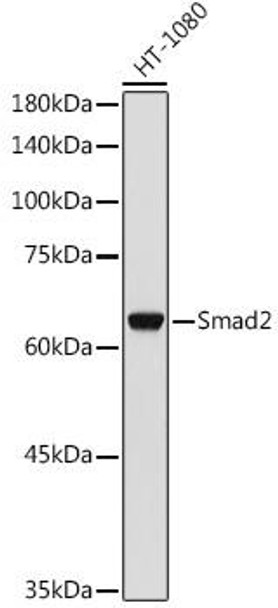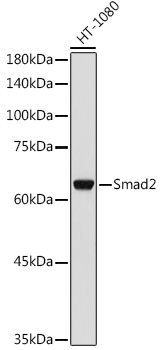Anti-Smad2 Antibody (CAB16912)
- SKU:
- CAB16912
- Product type:
- Antibody
- Reactivity:
- Human
- Mouse
- Rat
- Host Species:
- Rabbit
- Isotype:
- IgG
- Antibody Type:
- Polyclonal Antibody
- Research Area:
- Epigenetics and Nuclear Signaling
Description
| Antibody Name: | Anti-Smad2 Antibody |
| Antibody SKU: | CAB16912 |
| Antibody Size: | 20uL, 50uL, 100uL |
| Application: | WB IHC IF |
| Reactivity: | Human, Mouse, Rat |
| Host Species: | Rabbit |
| Immunogen: | A synthetic peptide of human Smad2. |
| Application: | WB IHC IF |
| Recommended Dilution: | WB 1:500 - 1:2000 IHC 1:50 - 1:200 IF 1:50 - 1:200 |
| Reactivity: | Human, Mouse, Rat |
| Positive Samples: | HT-1080 |
| Immunogen: | A synthetic peptide of human Smad2. |
| Purification Method: | Affinity purification |
| Storage Buffer: | Store at -20°C. Avoid freeze / thaw cycles. Buffer: PBS with 0.02% sodium azide, 50% glycerol, pH7.3. |
| Isotype: | IgG |
| Sequence: | Email for sequence |
| Gene ID: | 4087 |
| Uniprot: | Q15796 |
| Cellular Location: | Cytoplasm, Nucleus |
| Calculated MW: | 48kDa/52kDa |
| Observed MW: | 60KDa |
| Synonyms: | JV18, JV18-1, MADH2, MADR2, hMAD-2, hSMAD2, Smad2, SMAD2 |
| Background: | The protein encoded by this gene belongs to the SMAD, a family of proteins similar to the gene products of the Drosophila gene 'mothers against decapentaplegic' (Mad) and the C. elegans gene Sma. SMAD proteins are signal transducers and transcriptional modulators that mediate multiple signaling pathways. This protein mediates the signal of the transforming growth factor (TGF)-beta, and thus regulates multiple cellular processes, such as cell proliferation, apoptosis, and differentiation. This protein is recruited to the TGF-beta receptors through its interaction with the SMAD anchor for receptor activation (SARA) protein. In response to TGF-beta signal, this protein is phosphorylated by the TGF-beta receptors. The phosphorylation induces the dissociation of this protein with SARA and the association with the family member SMAD4. The association with SMAD4 is important for the translocation of this protein into the nucleus, where it binds to target promoters and forms a transcription repressor complex with other cofactors. This protein can also be phosphorylated by activin type 1 receptor kinase, and mediates the signal from the activin. Alternatively spliced transcript variants have been observed for this gene. |
| UniProt Protein Function: | SMAD2: ubiquitously expressed transcription factor phosphorylated and activated by TGF-beta receptor-type kinases. Participates in a wide range of critical processes including morphogenesis, cell-fate determination, proliferation, differentiation and apoptosis. Phosphorylated Smads dimerize with collaborating Smad4 and are translocated into the nucleus, where the transcription of target genes is stimulated. Two alternatively spliced isoforms have been described. |
| UniProt Protein Details: | Protein type:Transcription factor; DNA-binding Chromosomal Location of Human Ortholog: 18q21.1 Cellular Component: nucleoplasm; transcription factor complex; nuclear chromatin; cytoplasm; nucleus; cytosol Molecular Function:transcription activator binding; metal ion binding; transcription factor binding; transforming growth factor beta receptor, pathway-specific cytoplasmic mediator activity; phosphatase binding; protein binding; DNA binding; ubiquitin protein ligase binding; double-stranded DNA binding; chromatin binding; SMAD binding; transforming growth factor beta receptor binding; transcription factor activity Biological Process: developmental growth; somatic stem cell maintenance; positive regulation of transcription, DNA-dependent; activin receptor signaling pathway; paraxial mesoderm morphogenesis; gastrulation; palate development; primary microRNA processing; negative regulation of transcription from RNA polymerase II promoter; post-embryonic development; anterior/posterior pattern formation; negative regulation of cell proliferation; regulation of transforming growth factor beta receptor signaling pathway; ureteric bud development; transforming growth factor beta receptor signaling pathway; embryonic foregut morphogenesis; pancreas development; response to glucose stimulus; positive regulation of BMP signaling pathway; transcription initiation from RNA polymerase II promoter; pericardium development; cell fate commitment; regulation of binding; transcription, DNA-dependent; in utero embryonic development; common-partner SMAD protein phosphorylation; embryonic cranial skeleton morphogenesis; SMAD protein complex assembly; organ growth; zygotic determination of dorsal/ventral axis; mesoderm formation; endoderm formation; insulin secretion; gene expression; positive regulation of transcription from RNA polymerase II promoter; negative regulation of transforming growth factor beta receptor signaling pathway; negative regulation of transcription, DNA-dependent; lung development |
| NCBI Summary: | The protein encoded by this gene belongs to the SMAD, a family of proteins similar to the gene products of the Drosophila gene 'mothers against decapentaplegic' (Mad) and the C. elegans gene Sma. SMAD proteins are signal transducers and transcriptional modulators that mediate multiple signaling pathways. This protein mediates the signal of the transforming growth factor (TGF)-beta, and thus regulates multiple cellular processes, such as cell proliferation, apoptosis, and differentiation. This protein is recruited to the TGF-beta receptors through its interaction with the SMAD anchor for receptor activation (SARA) protein. In response to TGF-beta signal, this protein is phosphorylated by the TGF-beta receptors. The phosphorylation induces the dissociation of this protein with SARA and the association with the family member SMAD4. The association with SMAD4 is important for the translocation of this protein into the nucleus, where it binds to target promoters and forms a transcription repressor complex with other cofactors. This protein can also be phosphorylated by activin type 1 receptor kinase, and mediates the signal from the activin. Alternatively spliced transcript variants have been observed for this gene. [provided by RefSeq, May 2012] |
| UniProt Code: | Q15796 |
| NCBI GenInfo Identifier: | 13633914 |
| NCBI Gene ID: | 4087 |
| NCBI Accession: | Q15796.1 |
| UniProt Related Accession: | Q15796 |
| Molecular Weight: | 52kDa |
| NCBI Full Name: | Mothers against decapentaplegic homolog 2 |
| NCBI Synonym Full Names: | SMAD family member 2 |
| NCBI Official Symbol: | SMAD2 |
| NCBI Official Synonym Symbols: | JV18; MADH2; MADR2; JV18-1; hMAD-2; hSMAD2 |
| NCBI Protein Information: | mothers against decapentaplegic homolog 2; MAD homolog 2; mother against DPP homolog 2; Sma- and Mad-related protein 2; SMAD, mothers against DPP homolog 2 |
| UniProt Protein Name: | Mothers against decapentaplegic homolog 2 |
| UniProt Synonym Protein Names: | JV18-1; Mad-related protein 2; hMAD-2; SMAD family member 2; SMAD 2; Smad2; hSMAD2 |
| Protein Family: | Mothers against decapentaplegic |
| UniProt Gene Name: | SMAD2 |
| UniProt Entry Name: | SMAD2_HUMAN |





![Anti-Smad2 Antibody [KO Validated] (CAB19114) Anti-Smad2 Antibody [KO Validated] (CAB19114)](https://cdn11.bigcommerce.com/s-39x6lpnvxv/images/stencil/590x590/products/23203/21394/anti-smad2-antibody-ko-validated-cab19114__56888__83392.1644253345.jpg?c=1)
![Anti-Smad2 Antibody (CAB7699)[KO Validated] Anti-Smad2 Antibody (CAB7699)[KO Validated]](https://cdn11.bigcommerce.com/s-39x6lpnvxv/images/stencil/590x590/products/30126/28315/anti-smad2-antibody-cab7699ko-validated__94922__35923.1644317005.jpg?c=1)